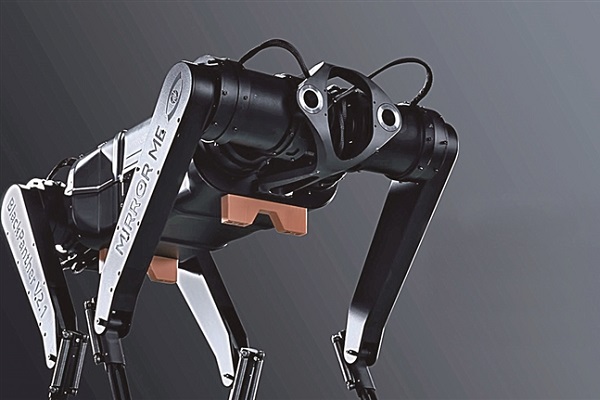Robot dog runs 100-meter dash in under 10 seconds

The robotic dog. [Photo/xsnet.cn]
A Chinese team has unveiled a robotic dog that sprinted into the "10-second club" of the 100-meter dash, marking a new technological advancement in robotics.
The impressive machine Black Panther 2.0, weighing 38 kilograms and standing 0.63 meters tall, achieves a remarkable peak stride frequency of 5 times per second, making it one of the world's fastest quadruped robots.
The researchers behind this project, a collaboration between a humanoid innovation institute under Zhejiang University and Hangzhou-based startup Mirror Me, took cues from the joints and paws of animals like black panthers and jerboas to improve the robot's high-speed movement in terms of strength, flexibility, power, precision and fluidity.
The team ingeniously fitted springs onto the knee joints of Black Panther 2.0 to serve as shock absorbers, said Jin Yongbin, a researcher from the institute.
To overcome the challenge of the robot's shins breaking at a running speed of 6 meters per second, they developed carbon-fiber shins inspired by the limbs of the jerboa desert rodent, which increased stiffness by 135 percent with only a 16 percent increase in weight.
The robot dog is also equipped with "running shoes" modeled after the claws of cheetahs, which enhances its grip performance by 200 percent.
"Animals have experience from long-term learning, but our limbed robots need to relearn with each step," said Jin, referencing the Huygens' coupled pendulum principle that allows the quadruped to coordinate into a unified gait. This principle states that when two pendulums are connected by a common support, they will eventually synchronize their motions.
Moreover, AI machine learning enables the robot dog to adjust its gait in specific situations.
Now, the team has developed advanced high-power-density, high-load motor drivers, laying the foundation for the next generation of industrial quadruped robots.
"Through the integration of software and components, we created a prototype within a mere three months," said Wang Hongtao, chief of the institute and a professor at Zhejiang University.
Black Panther 2.0 now outpaces most humans in sprinting, yet still lags behind fast runners on land like cheetahs, ostriches and wildebeests. In the future, the research team plans to further understand the gap between robots and living organisms, to potentially even surpass their mobility.
-
Xixi Wetland invites visitors to Huazhao Festival
March 25, 2025
-
Hangzhou sets standard for concert hosting
March 19, 2025
-
What is making Hangzhou the new tech powerhouse of China?
March 10, 2025
-
Inside Hangzhou: China's high-tech dream factory
March 12, 2025



